Global Water Cycle Variation and the Current World Water Resources Issues and Their Perspectives
It is alleged that the 21st century is the “century of water.” Wars over water may occur, like those fought over oil in the last century. The rapid increase in population and the coming global climate change could cause water scarcity.
This project attempts to develop global perspectives of such water resource issues by integrating field observations, predicting natural water cycles and human water usage in the future, and by establishing guidelines for sustainable development from the viewpoint of water resource issues.
Project Leader: KANAE Shinjiro Institute of Industrial Science, the Univiersity of Tokyo (RIHN until March 2007)
Specific Research Findings
Regarding the primary goal, which is, “showing perspectives and making projections”, we have succeeded in positioning our research on the cutting-edge, with the finest estimation and projection of global water cycles and resources in the world. For example, we successfully reproduced the daily fluctuation of land hydrological cycles through the past 100 years for the first time in the world. At the same time, we made a projection of land hydrological cycles for the next 100 years. Moreover, by estimating current and future water demands through an integration of all the estimations above, we have calculated current and future water stress on a global scale.
Contribution to “Earth-Environment Study”
We have succeeded in making an estimation and projection of global water cycles and resources paying attention to the interaction between humans and nature. It is, however, on a local scale that such an interaction is considered in the study of water circulation and water budgets. This interaction, especially on a global scale, has been overlooked. In this sense, our results can be a model of “Earth-Environment Study.” Besides, we also carried out research that dealt with specific areas with water problems, such as Thailand and California. Studies that analyzed policy tools for preventing water conflict and water shortage are additional examples of an interdisciplinary analysis.
Communication of Research Findings
Dr. Taikan Oki, the former leader and currently a core project member, was chosen as the lead author of the IPCC AR4 and the Millennium Assessment. Also our paper in Science has effectively promoted the achievement of this project. Moreover, our achievement on virtual water has been widely disseminated in domestic society through multiple media and a “White Book” on water resources made by the Japanese government. We hope our research results (Figure 1) become a seed for ideas for coming water-related projects.
 |
| Figure Annual Withdrawal to Availability Ratio The map shows the quotient obtained by dividing (expected water consumption for 2050) by (water availability forecast for 2050) of each geographic area. The quotient is high in areas painted red or yellow, in which available water is expected to be almost used up. In other words, red and yellow areas are candidate water crisis “hot spots.” |

